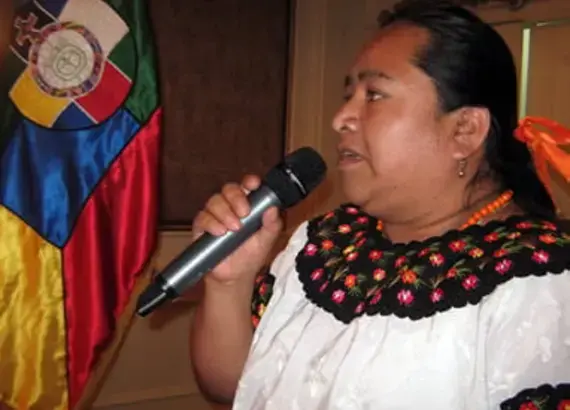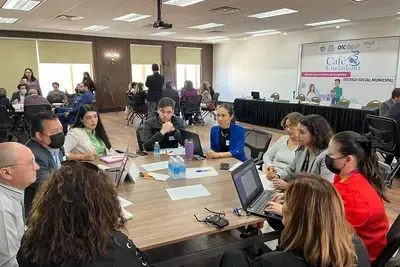
Success Story
Indigenous Woman Becomes Governor in Guatemala
Teresa de Jesús Chocoyo definitely stood out in the crowd when she was sworn in recently as one of 22 departmental governors in Guatemala, where non-indigenous men dominate politics. A petite indigenous woman in colorful, traditional Mayan dress, her long black hair pulled back in a braid, she was the only indigenous woman governor, one of only three women and three indigenous governors.
Know to her supporters as “Sacatepéquez’s Woman of Change” – she is the chief executive of the department of Sacatepéquez in the central part of the country – she is challenging the political status quo. She is also trying to take a proactive, hands-on approach to governing.
After taking office, she met with civil society representatives to identify the most pressing concerns of her constituents, one of which was security. In turn, she met with police and military leaders to design a coordinated approach for addressing crimes such as armed robbery and carjacking. She tells of receiving a late night call about a crime and immediately rushing to the scene while still in her pajamas. For Chocoyo, “many times it is not what we do, but our presence” that makes the largest impact, she said.
While Chocoyo’s training as a social worker helped prepare her to run for office , she also credits courses on political strategy and communication organized by NDI in partnership with the Guatemalan Office for the Defense of Indigenous Women (La Defensoría de la Mujer Indígena, DEMI) and UN Women.
These courses, offered in the months leading up to Guatemala’s general elections last September, taught her public speaking, media management and campaigning skills. Chocoyo ran for office and came very close to winning a seat in the country’s 158-member Congress.
"Even though there still are limitations, women must persevere."
She notes how during the campaign she made limited funding go a long way by focusing on grassroots campaigning. Her team of four people went door to door and sat in on community meetings to listen and respond to citizen concerns.
She also used “political mapping,” a strategy she learned from NDI that identifies potential supporters, to pinpoint nine indigenous communities whose votes would be necessary for her to win. The course gave her “the tools to construct our message, bring it to the people and identify the appropriate strategies and tactics for doing so,” she said.
Chocoyo’s loss in the legislative election was due largely to her placement as the third candidate of three candidates on her party’s—meaning voters would have had to overwhelmingly choose that party for her to be elected. However, as a result of Chocoyo’s work within her political party, her commitment to politics and the way her campaign resonated with the citizens, President Otto Pérez nominated her as governor of Sacatepéquez.
Chocoyo hopes to mentor other women and encourage them to participate in local politics. She believes that “countries where women are in power tend to have better economic, cultural and social development.” She knows, however, that recruiting more women will be no small feat, as “most women think first about their family and how money [earned from work] can help at home.”
To overcome this and other barriers, she underscores the importance of women political leader networks, whose members can serve as role models for other women. In her case, hearing about the experiences of women in other departments through the courses was motivating. Now she hopes to be an example herself and help change the political landscape in Guatemala.
“We must manage the department’s development, and not just be figureheads who sign papers,” she argues, emphasizing the importance of traveling to municipalities to learn about their realities, rather than sitting in a government office.
Chocoyo supports proposals to increase women’s participation in politics. With assistance from NDI, several national women’s groups and the Congressional Committee on Women have proposed a reform to the Law on Elections and Political Parties that would require gender parity and indigenous representation on party candidate lists. She concedes, however, that it remains in women’s hands to take the first step and “take the risk to run for office…Even though there still are limitations, women must persevere.”
Related:
- Download Estamos en Campaña, the training manual used in the program in which Chocoyo participated»
- Indigenous Guatemalan woman seeks mayoral seat with 'message of hope and opportunity'»
- NDI and Guatemalan Congress agree to work on making government more inclusive»
- Mayan women train one another to increase their political voice»
- Indigenous women strengthen leadership skills at Guatemalan academy»
Published June 11, 2012



